#dedekind numbers
Text
The task I wanted to do:
- task 1: Visualize the fourth dedekind number
What I needed to do in order to do task 1:
- task 1.1: Draw a hypercube and
- task 1.2: then give each of the 16 vertices a name - which is the 16 different "cells" (I dunno which word to use, sorry) of a venn diagram with 4 overlapping sets plus a circle around that 4-venn diagram.
- - -- ---
//additional info: For the 3rd dedekind number visualization I already posted I needed to use 20 cubes. Each of the 8 vertices of a cube was related to 3 sets - A, B and C - and the intersections of these sets. (AB, AC, BC, ABC)
You remember this post:
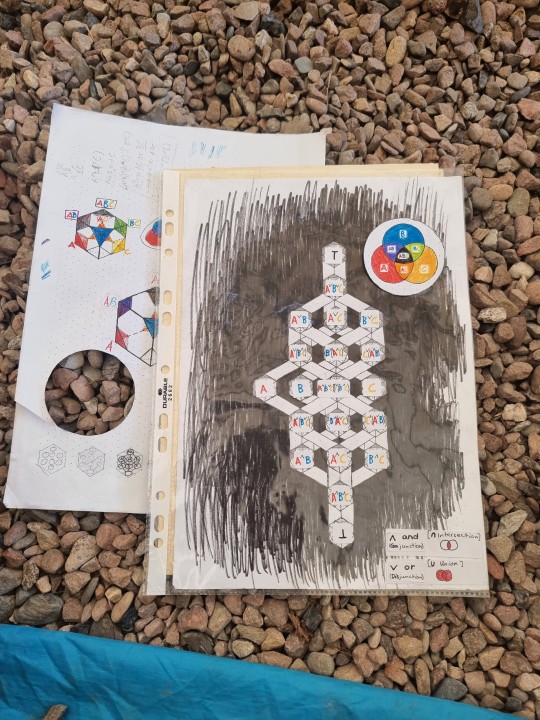
... and these details:
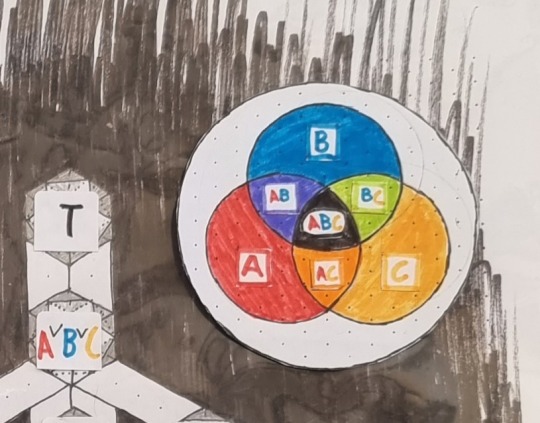

...and now back to the 4th dedekind number, which follows the same principle, - but in 4 dimensions.
- So we need a hypercube - and a 4th set/letter:
Now we have 4 letters - alias 4 sets
- and 11 combinations of these sets:
AB, AC, AD, BC, BD, CD, (6)
ABC, ABD, ACD, BCD, (4)
ABCD (1)
=> 11 different intersections + 4 "pure" sets. (sorry for ignorant wording)
So, we have 15 of these now. What is with the 16th (as the hypercube has 16 vertices)? Yeah, that one is the circle you imagine around the 4-set venn diagram.
- - -- ---
This is a 4-set venn diagramm btw:
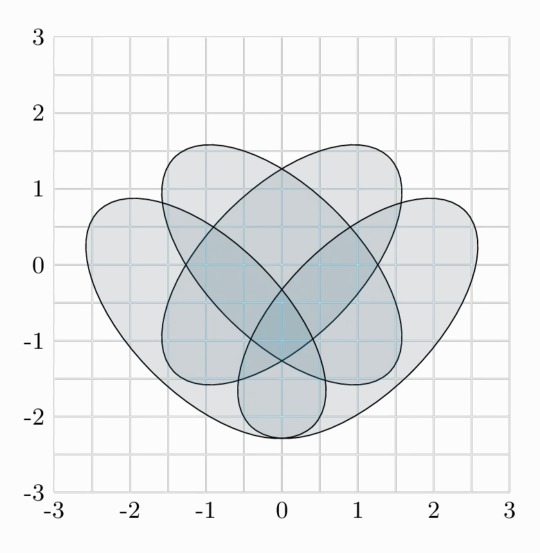
--- -- - -
So, back to me attempting to do the 4th dedekind-number visualization:
So I started to draw that venn diagram using ellipses, but I slightly altered it, because I wanted to use my isometric grid paper. (The angles of my drawing are different than in the picture depicted above.)
I started to draw the 4 ellipses, and I somehow started to see two intertwined/interlocked tubes due to the additional helplines I used for drawing.
Then I started to use my thicker black pen to make this effect of these two interlocked tubes more visible:
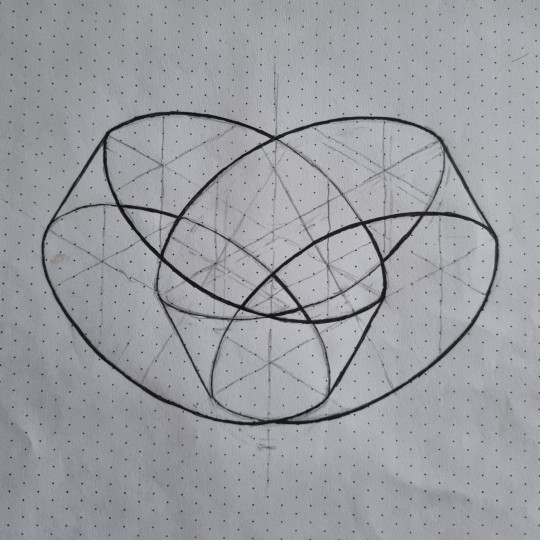
Now I plan to write the sets/letters at the backside of that piece of paper - in mirrored, so I can hold this piece of paper (with the tube drawing in front) against the light - and see the letters of the set names shining through.
i might also add some details to the tubes.
#my train of thought is the most dispersed scattered mess of whatever one might call this fuckery#... and yet in the end this clusterfuck of incoherent thought ramblings still make sense#the nonsense facility works nonsensically at producing non-nonsensical side-products#clusterfuck of nonsense thought ramblings#math#math or such idk#math art#dedekind numbers#venn diagram#venn diagrams#4th dedekind number#hypercube#set theory#sets#optical illusion#artsy#art#mathy art#my art#wip
65 notes
·
View notes
Text

Third Dedekind number illustration/visualization - WIP
#dedekind number#math art#mathy art#wip#numbers#math#maths#mathematics#color#colors#knottys art#visualization#math visualization#visualized math#mathy stuffy
89 notes
·
View notes
Text
Making history with 42 digits, scientists at Paderborn University and KU Leuven have unlocked a decades-old mystery of mathematics with the so-called ninth Dedekind number.
Experts worldwide have been searching for the value since 1991. The Paderborn scientists arrived at the exact sequence of numbers with the help of the Noctua supercomputer located there. The results will be presented in September at the International Workshop on Boolean Functions and their Applications (BFA) in Norway.
What started as a master's thesis project by Lennart Van Hirtum, then a computer science student at KU Leuven and now a research associate at the University of Paderborn, has become a huge success. The scientists join an illustrious group with their work. Earlier numbers in the series were found by mathematician Richard Dedekind himself when he defined the problem in 1897, and later by greats of early computer science such as Randolph Church and Morgan Ward. "For 32 years, the calculation of D(9) was an open challenge, and it was questionable whether it would ever be possible to calculate this number at all," Van Hirtum says.
Continue Reading
101 notes
·
View notes
Text
They did it, boys. It took 32 years and supercomputers, but they finally pulled it off.
They have calculated D(9), the ninth Dedekind Number.
Here it is. Are you ready for this?
286 386 577 668 298 411 128 469 151 667 598 498 812 366
How did they do it, you ask? Well, here is a handy chart:

...I have absolutely no idea what any of this means.
But it looks like those things in Kabbalah and Gnosticism that you use to control demons.

I'm not saying mathematicians are all mathemagicians. But I am saying that if they were all in fact evil wizards, I would not be able to tell.
15 notes
·
View notes
Text
when a mathematician who studies the real numbers wears a slutty little outfit they call it serving Dedekind cunt
24 notes
·
View notes
Text

Dedekind cuts: the unkindest cut of all. It segregates the rational numbers quite unfairly into all the smaller rational numbers versus all the larger rational numbers. We really should be treating all the rational numbers the same.
#white flower#macro photography#flowers of tumblr#original photographers#photographers on tumblr#flowers on tumblr#inner life of flowers#macro flower#flowers
8 notes
·
View notes
Text
In a world where I could magically change the lexicon, I think that "analytic numbers" is a much better name than "real numbers", because more than any sense of "reality" (meaningless - almost every real number is undefinable!), the real numbers are defined by an analytic criterion (Dedekind completeness).
"Algebraic number" unfortunately already has a useful meaning (is the root of a polynomial with integer coefficients) but in another universe would be a good name for the complex numbers (defined as they are as the algebraic closure of the reals).
7 notes
·
View notes
Note
This isn’t raygun, but I would say you are wrong re: prob-comb-history. Like, there’s a reason they call it the “Bernoulli distribution” (not my preferred name).
Besides that, I disagree. For instance, you talk about group theory, as a late 19th century concept, but already (abelian) groups are noticed by eg Kummer/Dedekind type algebraic number theory, in the mid-19th century, following Gauss’s earlier work on composition laws.
Other examples to be included are (1) Riemann surface theory/covering spaces, the direct precursor to turn of the 20th century algebraic topology a la Poincare, and (2) calculus of variations, 18th century and still exceedingly active in various guises.
Frankly, the nascent developing conversation seems misguided to me. The question must be refined. Of course the subjects alluded to above can be described in “20th century” terminology, but part of developing that terminology was to organize previous efforts.
Yeah, but I think I addressed this in my post. To wit:
So, ok, there's a sense in which many of these ideas existed in a different guise before they were formalized in the modern way. But the streamlining of all these messy, complex-seeming results from disparate parts of math into a single coherent set of frameworks is itself a useful development, it makes math easier, and these frameworks are part of what make modern math what it is. Modern mathematicians use them to fruitfully to do their job. Everything makes reference to groups, to topological spaces, to vector spaces, and so on.
The proto-topology of the nineteenth century contains in a sort of Platonic way "the same ideas" as the topology-per-se of today, but in terms of the ability to grab a problem and fruitfully throw topology techniques at it, they are not the same. The framing, the streamlining, the packaging—these are parts of the tool. In fact, you could argue that it's these very things that make all of mathematics powerful in the first place. It's not really the case, I think, that you could usefully frame the Zariski topology in terms of nineteenth century ideas about spaces. Maybe you could. But what we have today is much more powerful for that.
6 notes
·
View notes
Note
Hey, I just remembered about the math problems I promised.
The first one may be too easy, I'm not sure: let P be a total ordering with Q a dense subset of P (that is, for all x<y there is a z in Q such that x<z<y), prove that the cardinality of P is less or equal than the cardinality of the power set of Q (assuming choice).
The second one: show there is an embedding from ω^<ω into 2^<ω that preserves both the tree order and incompatibility; or prove it can't be done.
Note for the second one: ω^<ω is the set of all the sequences with image contained in ω and with a domain strictly smaller than ω, ordered with the inclusion (2^<ω is the same, but the images are contained in {0,1}=2).
Let me know if you have any questions on the statements!
I really like these questions! I'm not completely sure that I've understood question 2 correctly, but I think I have. Answers below:
We can think of the Dedekind cut construction of R, and use this to embed P in R. Every element of P corresponds to a cut in Q, and because Q is dense in P, each p in P gets a distinct cut. So this correspondence maps each element of P to a distinct real number. This shows in fact that P can be embedded in R, and the proof doesn't require choice.
Replace the characters in the string as follows:0 -> 1, 1 -> 01, 2 -> 001, etc. (e.g. 130 -> 0100011). Then every element of w^
2 notes
·
View notes
Note
How is Fermat more chaotic than the Cantor-Dedekind-Schröder-Berstein team up?
(my spelling sucks, sorry for that)
Cuz dude Fermat came up with idea that there ain't triplet (a,b,c) of Natural numbers where a^n=b^n + c^n where n>2, dared to die without proving it and left math society in collective chaos for next like, 4 centuries. Simple postulation yet total chaos. Absolute unhinged energy
I actually had no clue which theorem that was so I had to Google it. It's mostly called Cantor's theorem or just referred to by postulation. But theorem is so simple you can prove it in two rows, hende infinite times less chaotic than last Fermat theorem
Basically hypothesis was if you have two sets A and B and injective function f:A->B exists and injective function g:B->A exists then bijective function exists between those two sets. Since f is injection then f(x1)=f(x2) => x1 = x2 for every x1,x2 from A. Logical contraposition: x1=/=x2 => f(x1)=/=f(x2). Meaning |A| <= |B| (we can't say for sure they're equal cuz f isn't necessarily surjection). However with same logic applied to function g you get that |B|<= |A| hence it must be |A|= |B|. If two sets have same cardinality then bijective function exists between them. End of proof ■
I think theorem is named after all four (but noone really refers to it like that) cuz they either came up with it at same time or one established the hypothesis and others did the proof
7 notes
·
View notes
Note
you know how there are versions of set theory without infinity where only hereditarily finite sets exist- is it possible to have a model of ZF without infinity where the axiom of infinity is false- so no Dedekind infinite sets, but there are still sets that don't biject with any natural number?
or, what should I search to find an answer to this?
Yep! Let me call ZF without infinity and with the negation of infinity FZF (Finite ZF) (this is not standard terminology).
As you pointed out, the set of hereditarily finite sets V_{\omega} (or H_{\aleph_0} if you prefer) is a model of FZF (exercise). Since this is consistent, and V_{\omega} contains arbitrarily large sets, we can use the Compactness Theorem to show that there is a model of FZF with an infinite set. However, this would not have a bijection with the naturals internally because the naturals are not a set internally.
What might this model look like? An easy example is V_{\omega} in a model of ZF with nonstasdard natural numbers. Nonstandard naturals tend to be the standard naturals with some horrible, illfounded stuff stapled to the end. In this case, the model is not wellfounded (externally), so has infinite sets that it believes are finite.
Let me know if you'd like more details.
7 notes
·
View notes
Text
Today I went to the Technische Sammlungen Dresden with my friend, and it was very interesting!
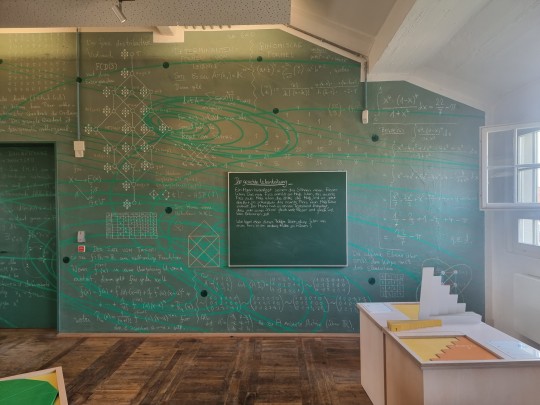

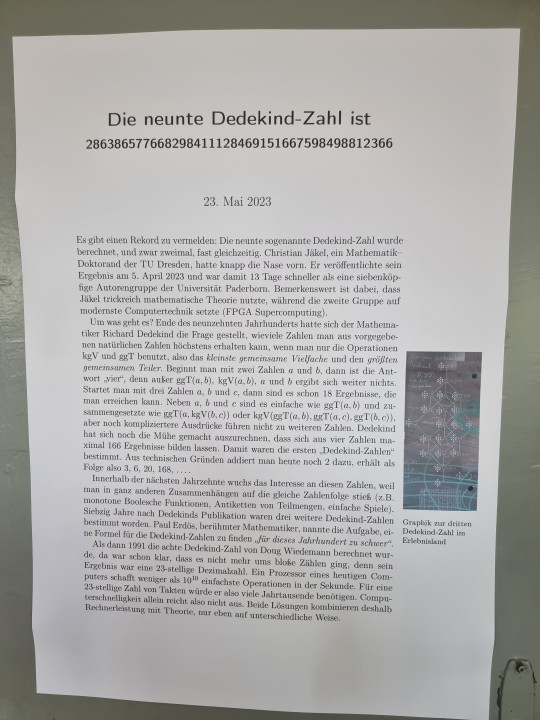
Torus (mug) and genus-2 torus (Pretzel) (has a pretzel 2 or 3 holes? 3 actually??? )
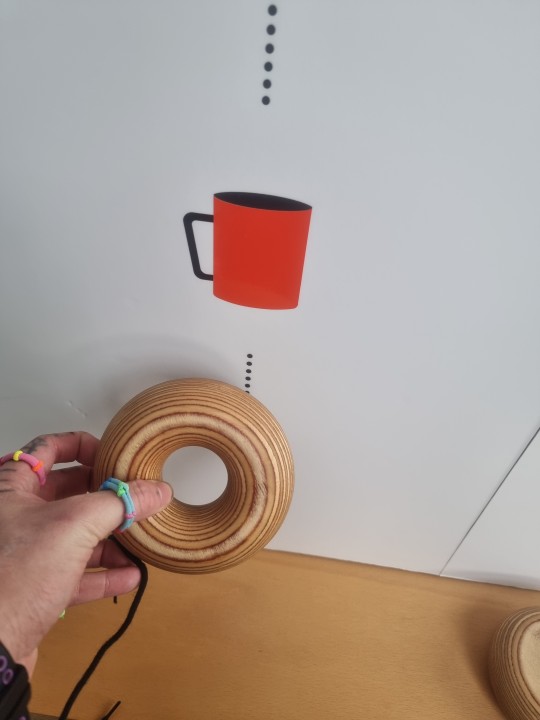

Möbius strip:

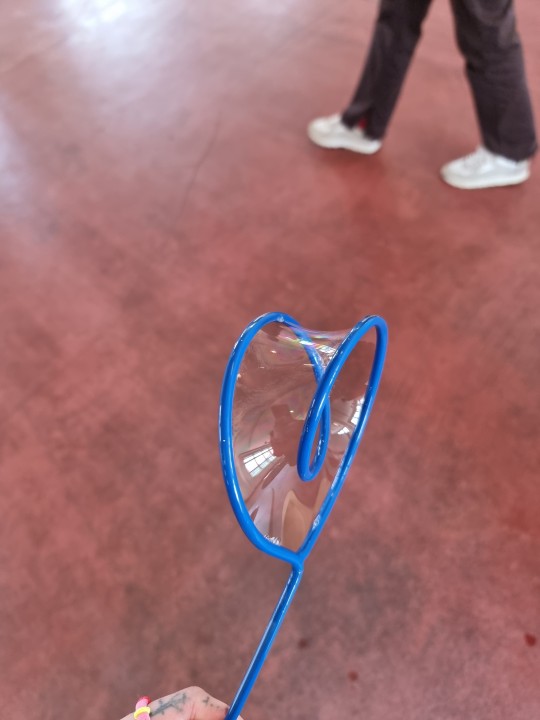
#technische sammlungen#math#mathematics#dedekind-number#torus#mug#topology#mobius strip#mathy#mathpost#mathy stuffy#math stuff
162 notes
·
View notes
Text
The quest for the ninth Dedekind number was a formidable challenge that spanned over 32 years. The calculations involved were so complex and involved such large numbers that it was uncertain whether D(9) would ever be discovered. But undeterred by the complexity and the enormity of the task, mathematicians continued their pursuit.
50 notes
·
View notes
Text
prof referred to "a" dedekind cut number instead of "the" and i instantly asked if this implied you can have more than one and we got a fun anecdote about using weird metrics to create a total order on the set of complex numbers and then do a dedekind cut
0 notes
Note
1, 3 and 10 for the math thing?
What is the coolest math concept you learned about this year?
construction of the real numbers from the rationals via dedekind cuts<33
3. What math concept did you struggle the hardest with this year?
the way i am literally sitting here with my notes on determinants trying to decide why any of this makes sense... yeah, probably that
10. Who is the most inspiring mathematician to you at the moment?Did this change throughout this year?
i mean other than you and @whywouldiconfessf for being inspiring in my personal life, i think i will always have to say emmy noether just because of her insane resilience, aptitude, and the physics connections :)
1 note
·
View note
Text
Ninth Dedekind number found by two independent groups
https://www.quantamagazine.org/ninth-dedekind-number-found-by-two-independent-groups-20230801/
1 note
·
View note